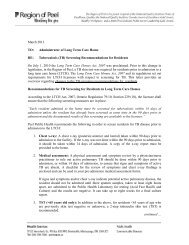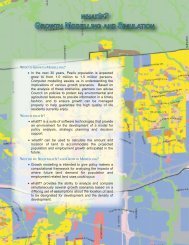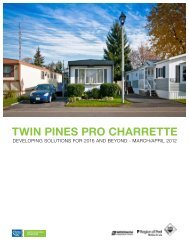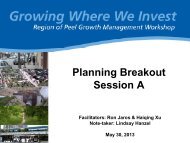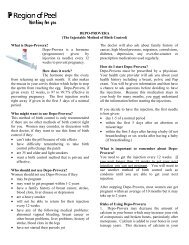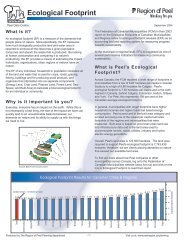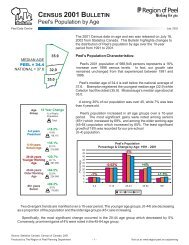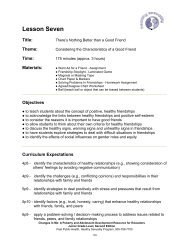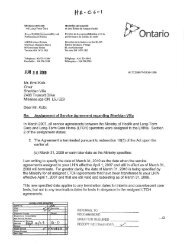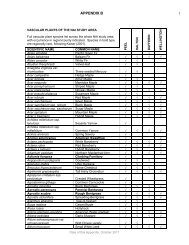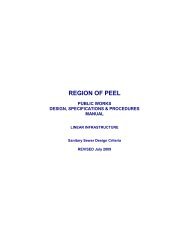FIFTH LINE – 22 SIDEROAD (LIMEHOUSE CA ... - Region of Peel
FIFTH LINE – 22 SIDEROAD (LIMEHOUSE CA ... - Region of Peel
FIFTH LINE – 22 SIDEROAD (LIMEHOUSE CA ... - Region of Peel
Create successful ePaper yourself
Turn your PDF publications into a flip-book with our unique Google optimized e-Paper software.
<strong>FIFTH</strong> <strong>LINE</strong> <strong>–</strong> <strong>22</strong> <strong>SIDEROAD</strong><br />
(<strong>LIMEHOUSE</strong> <strong>CA</strong> AND AREA)<br />
Species Presence<br />
Vascular Plants<br />
Plant biodiversity is high in this area. A total <strong>of</strong> 410 vascular plant species are recorded for this area,<br />
<strong>of</strong> which 291 (71%) are native. One <strong>of</strong> these, Butternut (Juglans cinerea), is Endangered both<br />
nationally and provincially, as well as being provincially rare (S-rank S3?; Table 3). One sapling and<br />
thirteen older Butternut trees were noted, most <strong>of</strong> which are mature trees. Cooper’s Milkvetch<br />
(Astragalus neglectus, S-rank S3) is provincially rare. Twenty-one species are regionally rare (Table<br />
4).<br />
Birds<br />
A total <strong>of</strong> 79 species <strong>of</strong> breeding birds are recorded, <strong>of</strong> which 77 (97%) are native. Four <strong>of</strong> these are<br />
Species At Risk. Bobolink (Dolichonyx oryzivorus) is Threatened nationally and provincially, Goldenwinged<br />
Warbler (Vermivora chrysoptera) and Canada Warbler (Wilsonia Canadensis) are Threatened<br />
nationally and Special Concern provincially and Eastern Meadowlark (Sturnella magna) is Threatened<br />
nationally.<br />
Interior forest habitat is present at this site, supporting eight species <strong>of</strong> area-sensitive forest interior<br />
birds, namely Hairy Woodpecker (Picoides villosus), Pileated Woodpecker (Dryocopus pileatus),<br />
Brown Creeper (Certhia americana), Winter Wren (Troglodytes troglodytes), Red-breasted Nuthatch<br />
(Sitta canadensis), Veery (Catharus fuscescens), Ovenbird (Seiurus aurocapilla) and Scarlet Tanager<br />
(Piranga olivacea). This site also supports three species <strong>of</strong> colonial-nesting birds, Great Blue Heron<br />
(Ardea herodias), Green Heron (Butorides virescens) and Bank Swallow (Riparia riparia), and at least<br />
three raptor species, Broad-winged Hawk (Buteo platypterus), Northern Goshawk (Accipiter gentilis)<br />
and Barred Owl (Strix varia). It supports one species <strong>of</strong> waterfowl, Common Merganser (Mergus<br />
merganser). Early successional habitat here supports six species <strong>of</strong> grassland birds, Bobolink,<br />
Eastern Kingbird (Tyrannus tyrannus), Eastern Meadowlark, Savannah Sparrow (Passerculus<br />
sandwichensis), Vesper Sparrow (Pooecetes gramineus) and Field Sparrow (Spizella pusilla); <strong>of</strong><br />
which three species (Bobolink, Eastern Meadowlark, Savannah Sparrow) are area-sensitive.<br />
Common Raven (Corvus corax) was found here, a species expanding its range south into the Credit<br />
River watershed.<br />
Fish<br />
Eighteen species <strong>of</strong> fish are recorded, <strong>of</strong> which 15 (83%) are native. One <strong>of</strong> these is a 1988 record <strong>of</strong><br />
American Eel (Anguilla rostrata), which is designated Special Concern nationally and Endangered<br />
provincially (Table 3). Three additional species are known from historic records including the<br />
nationally and provincially Endangered Redside Dace (Clinostomus elongates). Redside Dace is also<br />
provincially rare (S-rank S2). This natural area supports coldwater fish communities. Brook Trout<br />
(Salvelinus fontinalis), a coldwater stream species, was found in Black Creek.<br />
Butterflies, Skippers and Moths<br />
A total <strong>of</strong> 23 butterfly, skipper and moth species were recorded, <strong>of</strong> which <strong>22</strong> (96%) are native. On <strong>of</strong><br />
these species, Monarch (Danaus plexippus), is Special Concern nationally and provincially (Table 3).<br />
Some incidental moth species records are collected for this natural area.<br />
Dragonflies and Damselflies<br />
Fourteen dragonfly and damselfly species were recorded, all <strong>of</strong> which are native. Two <strong>of</strong> these,<br />
Swamp Spreadwing (Lestes vigilax) and Sweetflag Spreadwing (Lestes forcipatus) are regionally rare<br />
in Halton <strong>Region</strong> (Dwyer, 2006).<br />
Herpet<strong>of</strong>auna<br />
Thirteen herpet<strong>of</strong>aunal species were recorded, all <strong>of</strong> which are native. One <strong>of</strong> these, Eastern<br />
Milksnake (Lampropeltis triangulum triangulum), is Special Concern nationally and provincially (Table<br />
3). It is also provincially rare (S-rank S3). The remaining herpet<strong>of</strong>auna present here consist <strong>of</strong> six<br />
Date <strong>of</strong> this Site Summary: October 2011<br />
4



